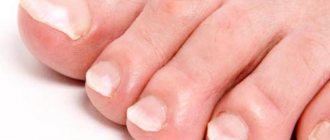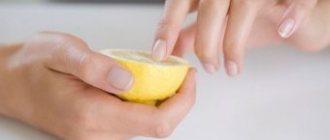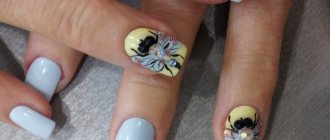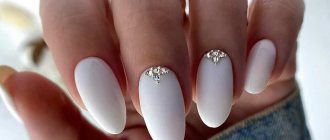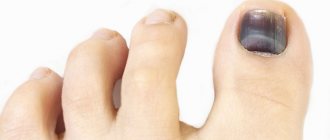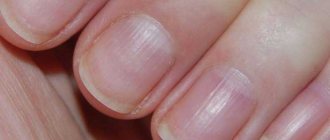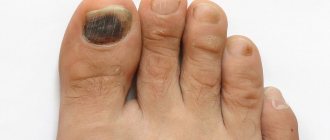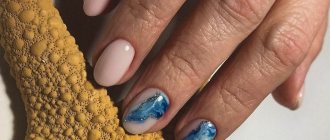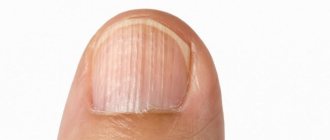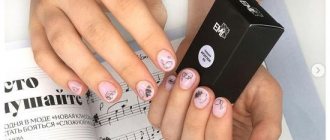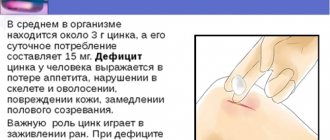Monitoring the condition of your nails is very important, as they can display information about the functioning of the body's internal systems. The appearance of white spots on the toenails should alert a person, because such a sign can signal a number of health problems.
Let's take a closer look at what white spots on toenails mean, whether they pose a threat, and what needs to be done in this case.
Features of the problem
A condition in which the toenail turns white is called leukonychia. This symptom can be observed quite often during the development of various diseases, however, unfortunately, few people pay attention to it in time.
Worth knowing! Women are more attentive to the condition of their nails, since they perform manicures more often. Despite this, even identifying a defect in the nail plate is not always a reason to see a doctor.
Usually women mask white spots with varnish so that they are not noticeable. This is a big mistake, since by doing so a person only hides possible health problems.
The appearance of white spots on toenails is most often caused by keratinization. This protein makes up 70% of the total mass of the nail plate. The remaining 30% is water, calcium, iron and vitamins.
Due to the influence of a number of external or internal factors, an imbalance of these substances may occur in the nails. This will lead to voids filled with air forming in areas where calcium, vitamins and other microelements should be. They will appear as white bubbles on the surface of the nail.
Features of treatment
The therapeutic course is based on the elimination of the provoking factor or the cause that led to the development of such symptoms. Treatment is conventionally divided into general measures, which are recommended regardless of etiology, internal therapy and external recovery methods.
What is onycholysis: causes and treatment of the disease
Common activities include:
- Normalization of psycho-emotional state, elimination of stressful situations.
- Changing your diet. It is recommended to enrich the menu with proteins, minerals and vitamins. The most beneficial are fermented milk products, seasonal fruits and vegetables.
- It is imperative to normalize sleep and rest. You need to sleep at least eight hours a day.
- Additional intake of vitamins and minerals in the form of a complex preparation. The choice is made individually depending on the deficiency of one or another component.
When the cause of white spots on the nail plate is any somatic pathology, then treatment of the underlying disease cannot be avoided. In this picture, the white spots are only a small part of the consequences. Therefore, it is necessary to strictly follow all doctor’s recommendations.
If a fungal infection is diagnosed, then medications for topical use are first prescribed - ointments, creams, etc. They are used for a long period of time, laboratory control is required. If there is no effect, systemic drugs are prescribed for oral administration.
External therapy methods
If the appearance of white spots is due to an exogenous nature, then it is permissible to use external methods of treatment. However, the source is eliminated first.
Note: during treatment, girls must refrain from manicures, decorative coatings and nail extensions.
Nail treatment at home:
- Add one teaspoon of sea salt per liter of hot water and shake. Lower your arms or legs for 15 minutes;
- Take a teaspoon of oak bark and chamomile, brew in 1 liter of water. Take a bath for 10 minutes;
- Rub fish oil into the affected nail plate every day.
Home remedies are effective, but they act relatively slowly, so sometimes you have to wait a really long time for results. As a quick and effective alternative, you can go to a beauty salon. Using specialized tools, the wizard will help you fix the problem in 2-3 sessions.
Causes
The development of this symptom can be influenced by external and internal causes. The first category includes the following factors:
- using inappropriate shoes;
- application of low-quality varnishes to the nail plate;
- careless cutting of the cuticle and, in general, traumatic manicure, which leads to damage to the nails;
- use of false nails;
- nail injury;
- the habit of tapping your nails on a hard surface, which leads to their cracking;
- using acetone-based nail polish removers;
- performing household work without gloves, which leads to contact of nails with chemicals.
Internal reasons for the appearance of white spots on nails can be:
- Cirrhosis of the liver.
- Dysbacteriosis caused by long-term use of antibiotics.
- The initial form of fungal nail infection.
- Nervous exhaustion, depression.
- Kidney damage.
- Eating disorder. This is one of the most common reasons. The formation of spots in this case occurs due to a lack of useful microelements in the body. Particularly dangerous are overly restrictive diets, which impair metabolism and lead to vitamin deficiency. Because of this, nails, skin, hair and even teeth suffer.
- Kidney failure.
- Heart lesions.
- Decreased immunity.
Important! Don't worry if white spots appear on the tips of your nails. In most cases, they are formed due to delamination or ordinary trauma to the plate. This defect can be quickly eliminated with the help of nail scissors and a nail file.
Why are there white spots on fingernails and toenails?
Many girls believe that white toenails are much less common than hands, but this is due to the fact that we always see the state of the manicure, and the feet are often hidden under socks or shoes.
Natural pedicure damage is very dangerous for anyone, as it is often caused by internal factors that need to be treated and eliminated.
Another name for pigmentation on the legs is leukonychia. It is not a disease, but it can negatively affect a woman’s health if its treatment and elimination of symptoms are neglected.
Leukonychia is most dangerous when the formation of white spots or stripes on the surface becomes an alarming signal from the body, which indicates the presence of diseases or problems in the girl’s body.
There are usually two types of such pigmentation:
- True. Appears as an alarm signal from the body when organ failures or dysfunction occur.
- False. It is a manifestation of the symptoms of any pathogens, the neutralization of which helps eliminate spots.
Visually, you will not be able to figure out what type of spots appear on your nails, so you need to consult a doctor to find out the cause of such symptoms.
Most often, leukonychia on the legs is harmless, as it appears due to a lack of vitamins in the body - this is the most common reason for the formation of spots. However, to find out the real reason for the formation of this type of pigmentation, you need to undergo an examination.
There are four types of symptoms:
- Limited. Appears in the form of one or two spots on one or several nails, which are located in a chaotic manner.
- Spot. On all toes of one foot and as the nail plate grows, they are at the same level relative to each other. Typically appear due to leg injury.
- Striped. It implies the formation on the nail bed not of dots, but of entire stripes. As a standard, they appear in a chaotic order, but on almost all nails.
- Absolute. It is impossible to distinguish individual spots - the entire nail becomes white or grayish.
The first type of leukonychia can occur in everyone, it is the most harmless and safe, the second type usually appears due to mechanical effects on the legs and does not require special treatment. And stripe and absolute pigmentation are the most dangerous types, as they appear when there are problems in the body.
Characteristic manifestations
White spots on nails can manifest themselves in various forms. Most often, clear dots or long thin stripes running across the entire nail are observed on the plates.
They can also have different areas of localization: they can be barely noticeable or large formations that affect more than half of the nail plate.
Depending on the specific cause, a white spot may appear on the toenails or appear on the hands and nails at the same time.
Fact! Human nails are a rudiment that he inherited from his ancestors. Today they do not perform a special vital function, but at the same time they well reflect the pathological disorders developing in the body.
Causes of white formations
The appearance of white spots of different shapes and sizes under the nail is called leukonychia in medicine. The exact causes of white spots have not yet been established.
Attempts by scientists and experienced physicians to determine the etiology of leukonychia have led to the identification of suspected factors leading to the formation of white spots under the nail plate. The reasons are divided into 2 categories: external and internal.
Internal causes of leukonychia
Endogenous factors that provoke the appearance of white spots include:
- Vitamin deficiency is a lack of important microelements and vitamins in the body. This includes poor nutrition, which leads to a lack of nutrients;
- metabolic disorder;
- fungal infection;
- intestinal dysbiosis;
- diets, fasting, anorexia;
- stress, depression, neurosis;
- diseases of the gastrointestinal tract, liver and kidneys;
- anemia (anemia);
- diseases of the cardiovascular system;
- intoxication of the body with salts of heavy metals: arsenic, mercury;
- joint diseases.
90% of people who are addicted to diets have leukonychia. White spots under the nail may also indicate diseases of the endocrine system.
External factors
Exogenous, or external, reasons for the formation of white spots on the toenails are also diverse. The occurrence of leukonychia is influenced by:
- damage, finger injuries, strong pressure applied to the nail. In women, injuries are associated with improperly performed pedicures and other cosmetic procedures;
- long-term wearing of false nails is the reason that air does not penetrate under the nail plate, as a result of which leukonychia appears;
- frequent contact with household chemicals - various detergents and bleaches, getting under the nail, lead to the formation of small white spots;
- the appearance of stains is caused by wearing tight shoes made of synthetic materials. A nail on the big toe that is white with spots also indicates various diseases;
- habit of biting off nails;
- application of poor quality varnish to the nail surface.
Leukonychia in children
The appearance of white spots under a child’s nails is preceded by a lack of important microelements, amino acids, vitamins A, C, and E in the body . Other causes of childhood leukonychia include: finger injuries, diseases of internal organs, cardiovascular pathologies, stress, and helminthic infestations.
Before contacting a pediatrician, parents need to find out the reasons for the formation of white spots under the nails of their offspring. Children worry when quarrels and scandals constantly occur in the family. Depression has a negative impact on a child’s health, so avoid conflicts at home in the presence of your beloved child.
If the pathology arose due to a lack of nutrients, then it can be eliminated with the help of a course of vitamin therapy and a balanced diet.
Varieties of leukonychia
Depending on the cause, the disease varies in shape and size. When the cause of white formations under the nail is vitamin deficiency, dieting, anorexia, the spots have an oblong appearance, and when the nail is injured, small rashes appear. Neuroses and stress lead to the appearance of a large white spot in the center of the nail. They are in form:
- dotted - leukonychia is characterized by the formation of white rashes of different sizes, resembling a dot;
- stripe-shaped - in this case, the spots look like stripes, located both vertically and horizontally.
Is it possible to identify the disease by spots?
In some cases, symptoms such as white spots on the nails can help diagnose a specific disease. To do this, use the following table:
| Possible disease | Characteristic features of nail lesions |
| Injury | Formation of pinpoint white spots |
| Gastrointestinal diseases | Large number of spots on toes |
| Damages of the heart and blood vessels | White spots on a blue nail |
| Fungus | Hardening of the nail, its yellowing and the appearance of white flaking spots |
| Lack of nutrients | The appearance of transverse paired stripes |
| Kidney damage | Formation of white spots on the pink nail plate |
| Nervous system problems | The appearance of a spot in the middle of the large nail plate |
Nail fungus (onychomycosis)
A fairly common fungal disease, the initial stage of which is characterized by the appearance of white longitudinal stripes and spots on the nail plate. As the fungal infection spreads, the nail becomes a dull gray or yellow color. Infected plates become denser, and over time begin to deform and crumble.
As the fungus progresses, it may happen that the toenail turns white and comes off. As a result of the disease, the plate becomes thicker and seems to rise, and in some cases an unpleasant odor appears.
In order not to bring the disease to a severe form, it is important to begin treatment of onychomycosis at an early stage of infection. Currently, a large number of new tools and methods are used in the treatment of nail fungus: from special varnishes, ointments and sprays to laser destruction of fungal spores.
Diagnosis and treatment methods
It’s worth noting right away that it’s very difficult to identify the root cause of nail problems on your own. In order not to make false conclusions, it would be wisest to contact a dermatologist, mycologist, gastroenterologist and cardiologist. After a comprehensive examination, specialists will help you understand what’s wrong.
As a rule, the following examinations are performed for nail lesions:
- Clinical blood tests;
- scraping the nail for fungus;
- checking hormone levels;
- Ultrasound examination of the digestive system.
Traditional treatment for nail lesions includes the following:
- Maintaining proper nutrition.
- Performing cosmetic procedures.
- Taking vitamins.
- Use of folk remedies.
When a specific disease is identified, drug therapy for a person should be selected by a doctor.
Worth knowing! You can speed up the process of nail restoration by using special care products and getting rid of stress.
How to cure nail plate detachment. Folk remedies.
Author of the article: Natalya Fedorova
Detachment of the nail from the nail bed is also called onycholysis . Some people do not pay due attention to this disease, although the problem is quite serious - ignoring treatment leads to an advanced form and gross defects of the nail plates that are difficult to remove .
What happens during onycholysis?
Detachment is a violation of the integrity of the nail plates. form under their surface , which causes the nails to separate from the soft tissues of the fingers.
There is a complete or partial change in the color of the nail plates. They may become pale yellow, whitish-gray, or less commonly bluish or brown. At first, the upper part of the nail or its sides are peeled off as the disease develops , the defect reaches its base - the entire surface moves away from the nail bed. But more often than not, it doesn’t come to this, and the nail plate is not completely separated.
Possible diseases due to nail detachment
Detachment of the nail plate can occur in some diseases, both chronic and acute. The most common are:
- problems with the gastrointestinal tract - ulcers, gastritis and other diseases;
- cardiovascular diseases;
- dysfunction of the central nervous system;
- endocrine system disorders.
These are systemic diseases. Onycholysis is also characteristic of:
- eczema and psoriasis;
- atopic dermatitis;
- bullous dermatosis.
Causes of onycholysis
The causes of detachment of the nail plate can be various factors of both infectious and non-infectious nature.
chemical factor for nail peeling
Non-infectious causes:
- Chemical – the disease manifests itself through frequent contact with household chemicals without the use of gloves or other substances. Such a product may be washing powder, nail polish, or nail polish remover.
- Mechanical – various injuries: strong blow, cutting, squeezing, habit of biting nails. In such cases, a hematoma (collection of blood) forms under the nail, which must be properly removed as soon as possible.
- Allergy. The same household products, latex, and nail polish can cause such a reaction. Often their peeling can be observed after coating with gel polish, which is popular today, but often causes allergies.
- Medications . This includes some groups of antibacterial drugs; the most common cause of nail splitting is treatment with fluoroquinolones.
- Manicures and pedicures performed incorrectly at home are also a common cause of onycholysis. Nails can begin to peel if you cut them carelessly, which leads to deformation, and when filing them, hold the file not perpendicular to the nail plate, but at an angle, and move the tool in different directions.
Onycholysis can be triggered by hormonal fluctuations, lack of vitamins and stressful situations.
Infectious causes include fungi, less commonly bacteria. In 40% of cases of the disease, onycholysis is caused by the first microorganisms. When they get on the nail plates, they destroy it, the nails begin to delaminate and break.
Lack of vitamins
Deficiency of vitamins and various macro- and microelements can also provoke detachment of the nail plate. Their deficiency usually occurs when eating poor food.
The diet must contain foods high in iron, calcium, and zinc . large amounts of magnesium, vitamin D, and phosphorus is ideal , without which calcium absorption is impossible.
B, A and E , found in apples, butter and sunflower oil, seeds, dairy products, and nuts, are also important for healthy nails
Also in the diet there should be the presence of protein products, vegetables and fruits containing silicon, amino acids, zinc and folic acid.
Types and causative agents of onycholysis
Depending on the cause that caused onycholysis, the following types are distinguished:
- traumatic;
- onycholysis caused by skin diseases;
- systemic (caused by systemic diseases);
- onycholysis caused by disturbances in the endocrine system;
- fungal or bacterial (more often with rubrophytosis, epidermophytosis);
Diagnosis of onycholysis
If you notice detachment of the nail plate, you should consult a dermatologist to determine the cause of this problem. If during the diagnostic process the doctor discovers concomitant diseases, he will refer the patient to another specialist . This is necessary in order to eliminate the factors that provoke onycholysis.
At the first appointment, the dermatologist visually examines the nail plates. It happens that the doctor immediately recognizes a fungal infection of the nails and refers the patient for an analysis (scraping), which reveals the type of pathogen. After this, appropriate treatment is prescribed.
If examination of the nails does not reveal the cause of their detachment, diagnostic methods such as:
- taking samples to determine the presence of fungus, staphylococci and streptococci;
- a blood test to assess the general condition of the body.
Other instrumental and laboratory diagnostics are also possible, the choice of which is based on the most likely cause of onycholysis.
Clinical picture
Symptoms of onycholysis depend on the cause that caused it.
In case of a disease that occurs after a nail injury, the following may occur:
- pain syndrome;
- hematoma formation;
- discoloration and weakening of the nail plate;
- bleeding.
If onycholysis is caused by an infection, you may experience:
Symptoms common to all types of onycholysis:
- the nail plate changes color, first stratifies in its upper part;
- unevenness, change in the border line dividing the nail plate into pink and white parts;
- the skin under the nail thickens;
- pain occurs only with secondary infection, due to microorganisms getting under the detached nail plate.
Treatment and medications for nail detachment
Onycholysis is a fairly persistent disease ; it cannot be cured in a short period of time. Elimination of symptoms can only occur after the nail has completely grown back .
The goal of treatment is to stop the detachment and eliminate its main cause. Therefore, complex therapy is used to get rid of onycholysis. The sequence of actions when detecting detachment of the nail plate:
- A visit to a dermatologist and, if necessary, a specialist doctor (gastroenterologist, endocrinologist and others) to eliminate the underlying disease as the cause of onycholysis. It is imperative to follow the prescribed treatment.
- Following a diet that includes foods with essential vitamins and minerals , plenty of protein foods, and foods containing gelling agents.
- Perform finger massage to increase blood circulation.
- Nail baths with the addition of potassium permanganate. After such procedures, synthomycin or heliomycin ointment is applied , fixed with a bandage and plaster, and the compress is left overnight.
If the diagnosis revealed health problems that caused nail separation, local therapy will not bring results. In such cases, the underlying diseases should be treated:
- When psoriasis or eczema is detected, corticosteroids are often prescribed to eliminate the inflammatory process.
- In cases of bacterial infection of the nails caused by staphylococci, antibiotics .
- Fungal infections require different treatment . To eliminate them, local preparations are used, including imidazole and allylamine . There are also medications that fight fungus for oral use, they are called systemic antimycotics . These include Griseofulfin, Terbinafine, Fluconazole, Ketoconazole, Intraconazole . Such drugs are taken only under the supervision of a doctor, as they have many contraindications and side effects. The course of treatment lasts from 3 months to a year , therapy is continuous. The doctor may also recommend baths with the addition of salt and soda. A new method of treating nail plate detachment caused by fungus is a laser aimed specifically at the pathogen under the stratum corneum. If the nail plate is deformed and there is severe pain, a specialist may recommend removing the nail plate.
- If the nail peeling is caused by an allergy, the irritant is determined . Contact with this substance is completely avoided. In some situations, a specialist will prescribe immunotherapy to reduce or eliminate allergies.
- When detachment of the nail plates appears after antibiotic therapy , it is necessary to restore the disturbed intestinal microflora. Natural fermented milk products can help with this . After the intestinal microflora returns to normal, nail peeling will stop.
First aid for a nail injury
, place your hand or foot under running cold water as quickly as possible . This is necessary to prevent the appearance of a hematoma under the nail , which provokes detachment of the nail plate. The injured limb should be kept in the cold for at least 15 minutes to constrict the blood vessels and eliminate pain.
To avoid swelling, an iodine mesh is applied to the skin and a tightening bandage is applied. This will minimize the risk of the nail moving away from the nail bed.
puncture to release blood from a hematoma
If a hematoma has formed, you should consult a doctor for a minor surgical intervention: a small hole is made in the nail so that the blood that has accumulated under it can come out.
If it is impossible to visit a specialist, you can try to carry out these manipulations at home under the condition of complete sterility . To do this, you need to thoroughly wash your hands and treat the bruise with an antiseptic solution, take a sterile needle, and heat it over a fire. After making a hole in the nail plate, remove the blood from under it. Then re-treat the nail.
If detachment of the nail plate occurs due to injury, you must immediately take the following steps:
- First you need to disinfect your tweezers or nail scissors. Use them to cut off the peeling part (if it is at the tip of the nail).
- Treat the nail plate and the tissue around it with an antiseptic solution (iodine, chlorhexidine).
- Add 2 tablespoons of sea salt and 5 drops of tea tree oil to 250 ml of water, pour the solution into a basin, and lower the injured limb there. Do the bath for 20 minutes , then blot dry with a towel.
- Apply a cream with soothing and regenerating properties ( “Bepanten”) . Repeat these procedures for several days.
- To prevent bacteria and fungi from growing under the peeling nail plate, you should maintain daily hygiene of your hands and feet .
The video discusses in detail nail puncture for bruises.
Treatment with folk remedies
Alternative medicine methods are used as additional methods for symptomatic treatment and disinfection.
orange juice with salt
A good remedy for strengthening nails is a solution of orange juice, a tablespoon of salt and 60 ml of warm mineral water. 5 drops of iodine are added to these components. Everything gets mixed up. Keep your fingers in this mixture for at least 10 minutes.
Kombucha has analgesic, anti-inflammatory and antibacterial properties. You can make a paste from it. Take a small part, cleared of films. Grind it up. Apply the resulting mass to the affected areas 2-3 times a day.
Several additional ways to treat a bruised nail at home in the video.
Measures to prevent nail plate detachment
To prevent a disease such as onycholysis, you must adhere to the following rules:
- You should only wear shoes that “breathe.”
- Socks should be chosen from materials that are highly breathable (cotton) . They should be changed every day.
- Do not wear tight shoes.
- After contact with water, wipe your hands or feet dry.
- When working with household chemicals, you should always wear gloves and dry them afterwards.
- It is necessary to properly organize your diet, excluding canned food, fatty and spicy foods . Necessary products are high in vitamins A, B, D, E, calcium and micro- and macroelements that promote its absorption, polyunsaturated acids.
- Treat with antibiotics as little as possible.
- It is imperative to treat chronic diseases in the acute phase.
- Avoid stressful situations, overwork, lack of sleep.
Thus, if preventive measures were not followed and symptoms of onycholysis appear, you should consult a specialist who will diagnose and prescribe adequate complex therapy. Self-medication in this case should not be allowed, since there are many reasons for the detachment of the nail plates, and it is impossible to establish them independently.
Nutritional Features
Proper nutrition plays a primary role in nail health. If they are affected, it is recommended to enrich the diet with fermented milk products, in particular cottage cheese, rich in calcium. Nuts, dried fruits, fish and meat dishes will also be useful.
In turn, it is better to eliminate spicy, smoked or too fatty foods, and alcoholic drinks from the menu.
If problems with nails occur due to fasting or following an irrational diet, it is important to return to a balanced diet rich in fresh vegetables and fruits, oils, cereals, liver, eggs, and cheese.
Taking vitamin
To restore nails, it is useful to take the following vitamins:
- Calcium. Helps strengthen nails and prevent microcracks.
- Zinc. Makes nails look ugly and shiny.
- Iron. Strengthens nails.
- Vitamins A, C and E. They are essential for healthy nails.
To quickly get rid of problems with nails, experts recommend taking complex preparations, which should include vitamins A, C, E. The best of them are:
- Aekol;
- Lutamevit;
- Vitasharm;
- Aevit.
Preventive recommendations
The following tips will help reduce the risk of leukonychia:
- Massage your hands regularly. It will improve blood circulation and help nourish the nails.
- Make healthy homemade baths using sea salt.
- Rub vitamin oil solutions into your nails. Fish oil and olive oil are suitable for this.
- Use high-quality varnishes and carefully monitor nail hygiene.
- Eat a well-balanced diet rich in nutrients. Following strict diets and especially fasting are the enemies of healthy nails.
- Do housework with gloves.
- Take vitamins during the off-season period.
- Treat any diseases of the digestive system in a timely manner.
- Undergo regular preventive examinations.
- Use only comfortable shoes.
( 2 ratings, average: 5.00 out of 5)
